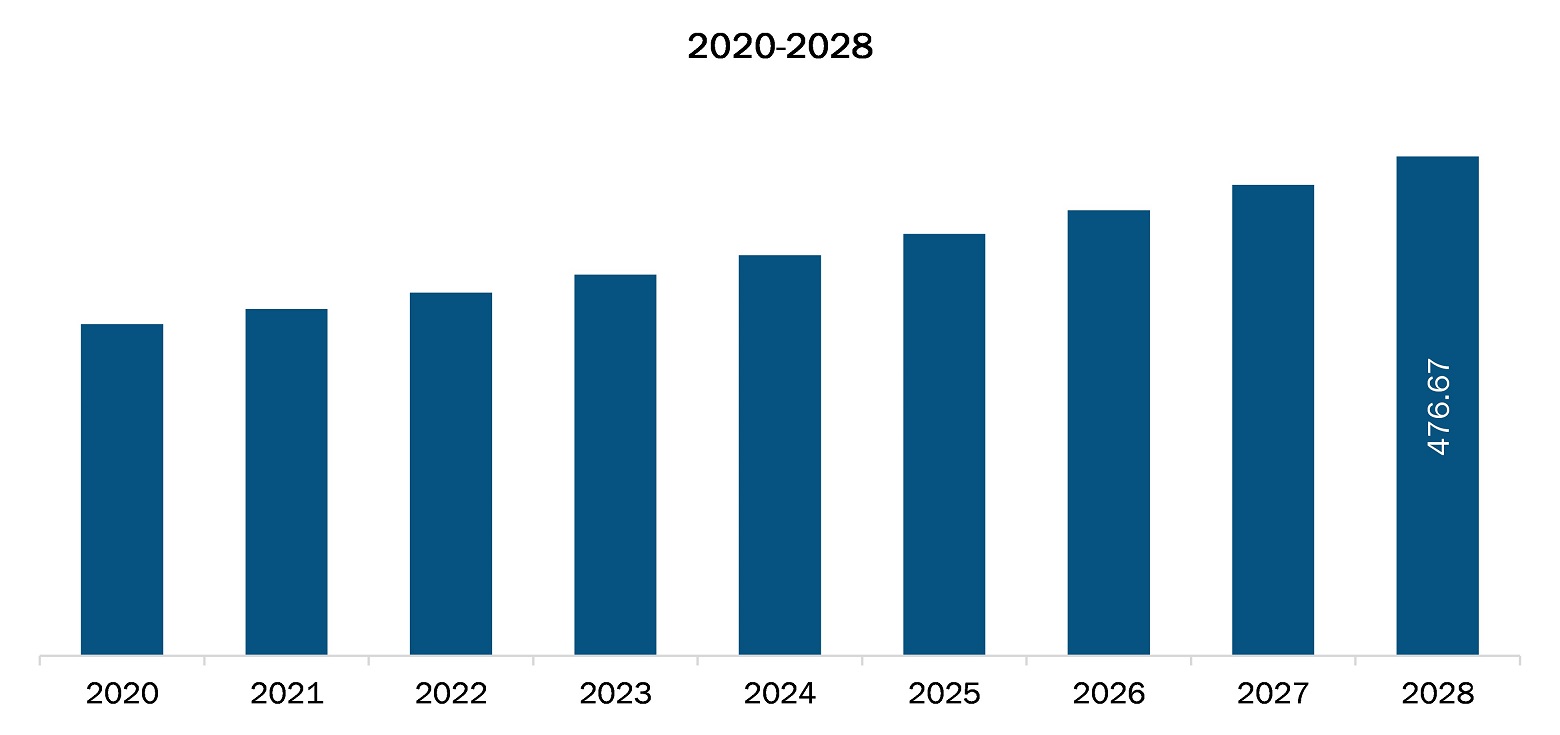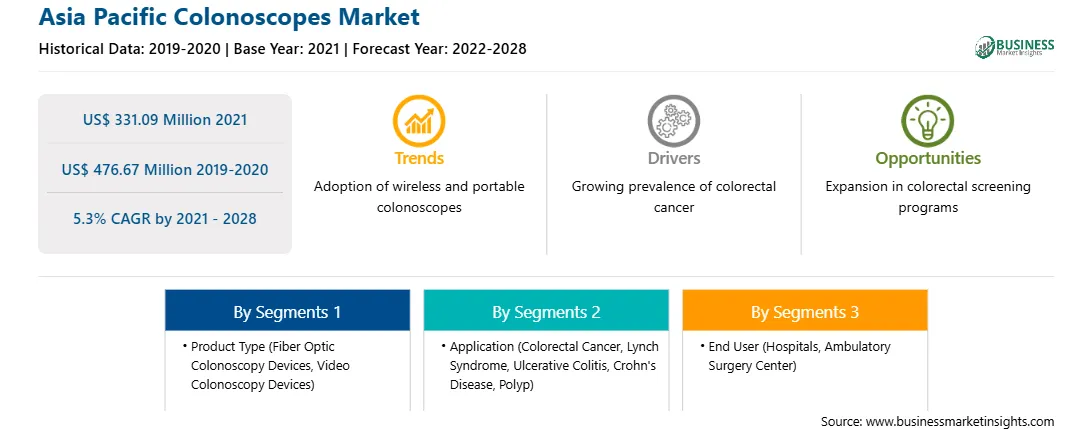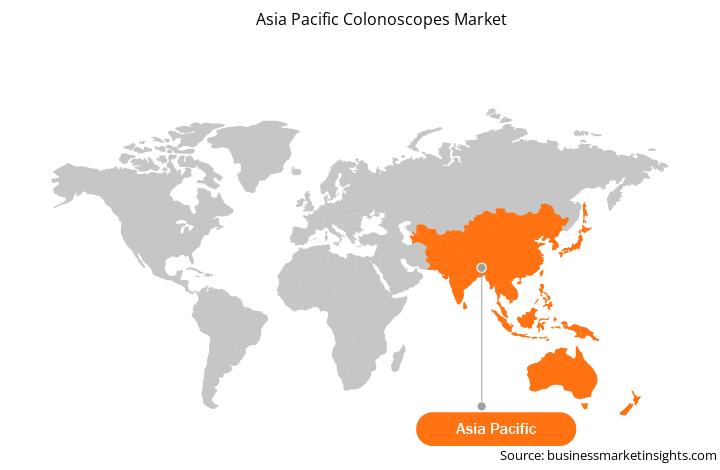Colonoscopes are used for the removal of foreign bodies, excision of tumors or colorectal polyps (polypectomy), and control of hemorrhage. Routine colonoscopy is important in diagnosing intestinal cancer, the second leading cause of cancer deaths in the United States. These endoscopic procedures reduce the need for invasive surgical diagnostic and therapeutic procedures.

Strategic insights for the Asia Pacific Colonoscopes provides data-driven analysis of the industry landscape, including current trends, key players, and regional nuances. These insights offer actionable recommendations, enabling readers to differentiate themselves from competitors by identifying untapped segments or developing unique value propositions. Leveraging data analytics, these insights help industry players anticipate the market shifts, whether investors, manufacturers, or other stakeholders. A future-oriented perspective is essential, helping stakeholders anticipate market shifts and position themselves for long-term success in this dynamic region. Ultimately, effective strategic insights empower readers to make informed decisions that drive profitability and achieve their business objectives within the market.

| Report Attribute | Details |
|---|---|
| Market size in 2021 | US$ 331.09 Million |
| Market Size by 2028 | US$ 476.67 Million |
| Global CAGR (2021 - 2028) | 5.3% |
| Historical Data | 2019-2020 |
| Forecast period | 2022-2028 |
| Segments Covered |
By Product Type
|
| Regions and Countries Covered | Asia-Pacific
|
| Market leaders and key company profiles |
The geographic scope of the Asia Pacific Colonoscopes refers to the specific areas in which a business operates and competes. Understanding local distinctions, such as diverse consumer preferences (e.g., demand for specific plug types or battery backup durations), varying economic conditions, and regulatory environments, is crucial for tailoring strategies to specific markets. Businesses can expand their reach by identifying underserved areas or adapting their offerings to meet local demands. A clear market focus allows for more effective resource allocation, targeted marketing campaigns, and better positioning against local competitors, ultimately driving growth in those targeted areas.

The Asia Pacific colonoscopes market is expected to reach US$ 476.67 million by 2028 from US$ 331.09 million in 2021, it is estimated to grow at a CAGR of 5.3% from 2021 to 2028. A few factors such as the increasing adoption of disposable colonoscopes, growing research activities to extend its applications in therapeutic areas, and development of robotic colonoscopes are driving the growth of the market. However, the availability of alternative diagnostic tests for rectal diseases hampers the market growth.
Early detection of colorectal cancer (CRC) in gastroenterology through national screening can cure a patient. However, there is still a significant variation in lesion detection via colonoscopy. The adenoma detection rate (ADR) is the gold standard for evaluating the quality of the endoscopist in screening for CRC. Improved ADR is driven by imaging technology, withdrawal technique, endoscopist knowledge, and motivation, as well as environmental and social factors. In endoscopy, AI broadly relates to computer vision technology, which allows computers to 'see' and interpret visual content. Through machine learning processes, and more recently, deep learning, AI systems can be trained to recognize 'normal' characteristics by linking a gold standard to suitable images. Using computer vision for lesion detection will be the first application of AI in gastroenterology. It will help to improve the quality of endoscopy practice in finding and recognizing polyps on colonoscopy. AI in colonoscopy is a new field with a new curriculum, but it can improve the quality of endoscopy and patient care. AI in endoscopy provides effective lesion detection and a valuable learning platform for the endoscopist. Hence the increasing adoption of AI in colonoscopy will change the management of performance and quality improvement in colonoscopy, with the potential to improve several key performance measures in future. Also, the rising adoption of disposable colonoscopes to avoid colonoscopy-related infections and complications propels the growth of the market.
The interruptions in the supply chain and the massive demand for efficient treatments for COVID-19 have put the health research industry in Asia Pacific in a crucial position. The COVID-19 pandemic has largely affected the economies in the region. Medical device manufacturers and suppliers are shifting their focus on developing and supplying COVID-19 essentials and medical devices for respiratory diseases. This scenario harms the market. The COVID-19 pandemic has also disrupted the spectrum of cancer care, including delaying diagnoses and treatment and halting clinical trials. In response, healthcare systems are rapidly reorganizing cancer services to ensure that patients continue to receive essential care while minimizing exposure to SARS-CoV-2 infection. Colon cancer (CRC) is one of the most common malignancies in Asia Pacific, and many countries in this region have introduced CRC screening for the population. Screening organizers coordinate with health authorities to work out how to manage screening residues, prioritize screening, and use modern technology to overcome potential barriers. Many new approaches such as the risk-stratified approach that considers personal CRC risk and local epidemic status and new digital technologies, are expected to play an important role in CRC screening in the future. During the pandemic, some facilities have also used at-home methods for CRC screening, such as fecal immunochemical testing (FIT) and multitarget stool DNA (mt-sDNA) tests, to help fill the gaps in screening. Hence, such factors would have a limited positive influence on the market growth in the coming years.
The Asia Pacific colonoscopes market, by product type, is bifurcated into fiber optic colonoscopy devices and video colonoscopy devices. The fiber optic colonoscopy devices segment held a larger share of the market in 2021, and the same segment is anticipated to register a higher CAGR in the market during the forecast period.
The Asia Pacific colonoscopes market, based on application, is segmented into colorectal cancer, lynch syndrome, ulcerative colitis, crohn’s disease, and polyp. In 2021, the colorectal cancer segment held the largest share of the market. Also, the market for the same segment is expected to grow at the fastest rate in the coming years.
The Asia Pacific colonoscopes market, based on end user, is segmented into hospitals, ambulatory surgery center, and others. In 2021, the hospitals segment held the largest share of the market. Further, the market for the same segment is expected to grow at the fastest rate in the coming years.
A few of the primary and secondary sources referred to while preparing the report on the Asia Pacific colonoscopes market are the Asian Pacific Society of Digestive Endoscopy (APSDE), National Institute of Metrology, Quality and Technology (INMETRO), Gastroenterological Society of Australia (GESA), and Australian Gastrointestinal Endoscopy Association (AGEA).
The Asia Pacific Colonoscopes Market is valued at US$ 331.09 Million in 2021, it is projected to reach US$ 476.67 Million by 2028.
As per our report Asia Pacific Colonoscopes Market, the market size is valued at US$ 331.09 Million in 2021, projecting it to reach US$ 476.67 Million by 2028. This translates to a CAGR of approximately 5.3% during the forecast period.
The Asia Pacific Colonoscopes Market report typically cover these key segments-
The historic period, base year, and forecast period can vary slightly depending on the specific market research report. However, for the Asia Pacific Colonoscopes Market report:
The Asia Pacific Colonoscopes Market is populated by several key players, each contributing to its growth and innovation. Some of the major players include:
The Asia Pacific Colonoscopes Market report is valuable for diverse stakeholders, including:
Essentially, anyone involved in or considering involvement in the Asia Pacific Colonoscopes Market value chain can benefit from the information contained in a comprehensive market report.